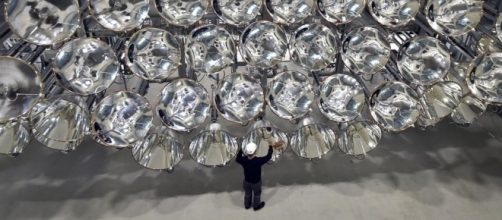Last week, scientists in Germany officially turned on what many people are calling Earth's "largest Artificial Sun." The giant structure of spotlights is officially called "Synlight" and has a setup that makes it look like a giant honeycomb. Synlight is found in the German city of Juelich.
What is Synlight?
Synlight uses an array of 149 special xenon short-arc lamps that have a combined power of 350-kilowatts and are usually reserved for use in movies to simulate the effects of natural sunlight. The scientists in change of the device at the German Aerospace Center (DLR) will be able to use these spotlights to simulate lesser sun-like conditions in terms of heat and radiation.
If the entire 149 spotlights focused on one 20-by-20 centimeter (8-by-8 inch) location, Synlight would be able to produce what is equal to 10,000 times the amount of solar radiation that the sun's rays would usually shine on the same surface. This also creates temperatures that can reach up to 5,432 degrees Fahrenheit (3,000 Celsius), which is hot but still not close to the surface temperature of the Sun at 9,941 degrees Fahrenheit (5,505 Celsius).
How do scientists intend to use Synlight?
Synlight's power to act as a kind of artificial sun has scientists at DLR buzzing about its potential. Focusing so much light on such a small area, as described in the previous section, will be key to testing unorthodox ways of making hydrogen.
This gives scientists hope that it could potentially help them find new ways to make hydrogen fuel, which is climate-friendly. Since hydrogen fuel does not produce any carbon emissions, it could be a potential fuel of the future, but it is a rare element on Earth.
Scientists at DLR hope they can take hydrogen-making experiments to the next level from experiments done in smaller labs -- hopefully reaching a level fit for industry once hydrogen-making techniques are mastered. The other end goal for Synlight is to act as a testing point until scientists can take the next step of trying to use real sunlight in hydrogen-making and other experiments.

